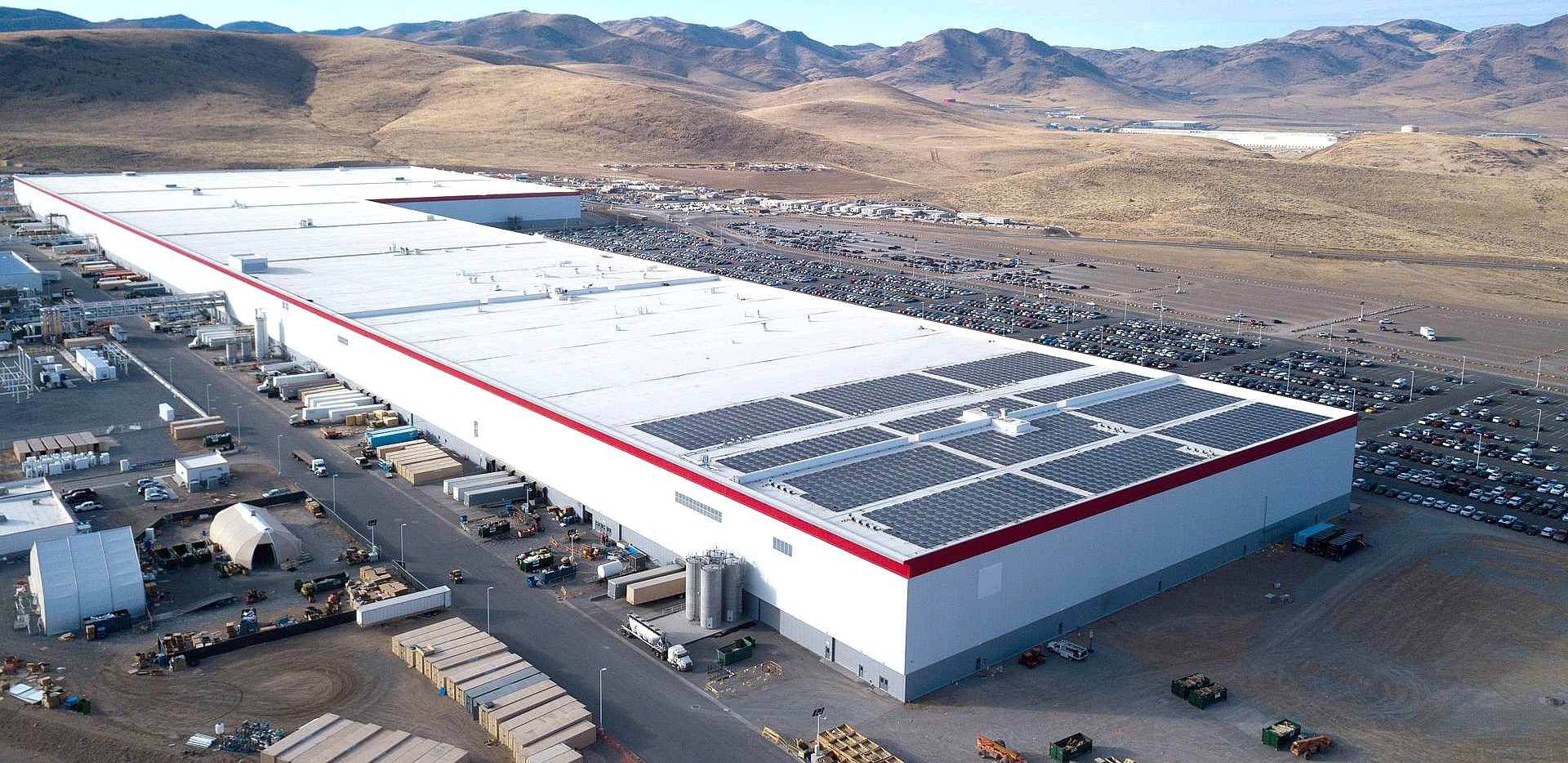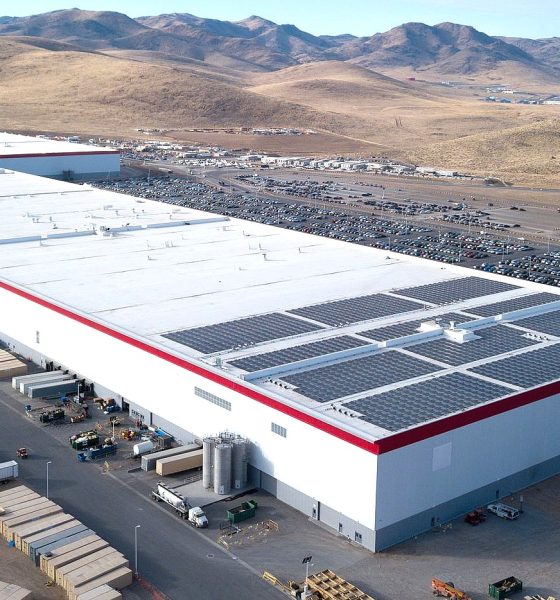

Investor's Corner
Tesla battery partner Panasonic sees higher Gigafactory output, cites Model S/X demand increase
Panasonic President Kazuhiro Tsuga recently discussed some details about the Japanese corporation’s existing operations with American electric car maker Tesla. According to the executive, Panasonic expects to see higher yields from Gigafactory 1 as operations get optimized, and there could be a potential upside in Model S and X demand as Tesla takes actions to make its flagship vehicles more attractive to consumers.
Tsuga’s comments about Tesla were a response to an inquiry during a Q&A session following Panasonic’s release of its fiscal 2019 financial results. Tsuga pretty much confirmed what Elon Musk mentioned on Twitter last month, stating that Gigafactory 1 is currently operating at about 24 GWh despite the facility having a theoretical capacity of 35 GWh. “For Tesla, 35 GWh initial investment has been completed already, and utilization as per Elon is maybe 24 GWh currently. This year, we want to increase this (utilization) rather significantly,” he said.
Explaining further, Tsuga noted that efficiencies in Gigafactory 1 should improve in the near future, particularly as its higher-speed production lines get optimized further. “Including the lines that have yet to start, we have three fast, higher speed lines, and when they become operational, we will see improved efficiency. And when we shifted tools, we were not really able to do sufficient verification of the facilities. We saw disruptions, and we now know the reasons. And so in June, we will start replacing the jigs, and therefore, the number of cells and the yield will improve quite a bit,” Tsuga said.
Among the improvements mentioned by the Panasonic President involved tapping into the local workforce for the Nevada Gigafactory. This, according to the executive, will ultimately lower fixed costs. Tsuga also noted that he expects the demand from Tesla to be good enough for the full capacity of its production lines on the site.
“Through the localization of the workforce, we will have fewer Japanese expats (on Gigafactory 1), and that is progressing. And we are seeing an increase in the number of lines that can be operated only by the local personnel, and that can reduce fixed costs as well. So overall, we can expect improvement. Of course, the demand from Tesla is going to be good enough for the full capacity (of our equipment), that is the assumption. Should that assumption hold, the Tesla battery business can break even this year (for Panasonic),” he added.
Particularly compelling were Tsuga’s comments about the demand for batteries used in Tesla’s flagship vehicles, the Model S and Model X, both of which utilize 18650 cells. While sales of the flagship sedan and SUV have seen a drop in recent months, the Panasonic President stated that demand for the Model S and X could increase once more, especially as Tesla takes the initiative to push the vehicle to customers. “As for Model X (and S), last quarter, we saw a decline, but Tesla is already making efforts and taking actions to revamp that demand. We’re talking with Tesla on this, and so there is upside potential there,” Tsuga said.
The comments from the Panasonic President about the Japanese corporation’s partnership with Tesla all but suggests that the two companies remain closely working with each other to improve the output of Gigafactory 1. Speculations about Panasonic moving away from its partnership with Tesla made the rounds in the media last month, fueled by a report from the Nikkei Asian Review which stated that the Japanese company is freezing its investments in the Nevada-based facility. Tesla responded to the Nikkei report when it was released, explaining that there is far more output to be gained by improving the facility’s existing lines than previously estimated. These comments seem to be in step with the Panasonic President’s recent statements.
Panasonic President Kazuhiro Tsuga’s discussion on Tesla could be accessed here (kindly skip to 33:28 in the video).

Investor's Corner
Tesla price target boost from its biggest bear is 95% below its current level

Tesla stock (NASDAQ: TSLA) just got a price target boost from its biggest bear, Gordon Johnson of GLJ Research, who raised his expected trading level to one that is 95 percent lower than its current trading level.
Johnson pushed his Tesla price target from $19.05 to $25.28 on Wednesday, while maintaining the ‘Sell’ rating that has been present on the stock for a long time. GLJ has largely been recognized as the biggest skeptic of Elon Musk’s company, being particularly critical of the automotive side of things.
Tesla has routinely been called out by Johnson for negative delivery growth, what he calls “weakening demand,” and price cuts that have occurred in past years, all pointing to them as desperate measures to sell its cars.
Johnson has also said that Tesla is extremely overvalued and is too reliant on regulatory credits for profitability. Other analysts on the bullish side recognize Tesla as a company that is bigger than just its automotive side.
Many believe it is a leader in autonomous driving, like Dan Ives of Wedbush, who believes Tesla will have a widely successful 2026, especially if it can come through on its targets and schedules for Robotaxi and Cybercab.
Justifying the price target this week, Johnson said that the revised valuation is based on “reality rather than narrative.” Tesla has been noted by other analysts and financial experts as a stock that trades on narrative, something Johnson obviously disagrees with.
Dan Nathan, a notorious skeptic of the stock, turned bullish late last year, recognizing the company’s shares trade on “technicals and sentiment.” He said, “From a trading perspective, it looks very interesting.”
Tesla bear turns bullish for two reasons as stock continues boost
Johnson has remained very consistent with this sentiment regarding Tesla and his beliefs regarding its true valuation, and has never shied away from putting his true thoughts out there.
Tesla shares closed at $431.40 today, about 95 percent above where Johnson’s new price target lies.
Investor's Corner
Tesla gets price target bump, citing growing lead in self-driving

Tesla (NASDAQ: TSLA) stock received a price target update from Pierre Ferragu of Wall Street firm New Street Research, citing the company’s growing lead in self-driving and autonomy.
On Tuesday, Ferragu bumped his price target from $520 to $600, stating that the consensus from the Consumer Electronics Show in Las Vegas was that Tesla’s lead in autonomy has been sustained, is growing, and sits at a multiple-year lead over its competitors.
CES 2026 validates Tesla’s FSD strategy, but there’s a big lag for rivals: analyst
“The signal from Vegas is loud and clear,” the analyst writes. “The industry isn’t catching up to Tesla; it is actively validating Tesla’s strategy…just with a 12-year lag.”
The note shows that the company’s prowess in vehicle autonomy is being solidified by lagging competitors that claim to have the best method. The only problem is that Tesla’s Vision-based approach, which it adopted back in 2022 with the Model 3 and Model Y initially, has been proven to be more effective than competitors’ approach, which utilizes other technology, such as LiDAR and sensors.
Currently, Tesla shares are sitting at around $433, as the company’s stock price closed at $432.96 on Tuesday afternoon.
Ferragu’s consensus on Tesla shares echoes that of other Wall Street analysts who are bullish on the company’s stock and position within the AI, autonomy, and robotics sector.
Dan Ives of Wedbush wrote in a note in mid-December that he anticipates Tesla having a massive 2026, and could reach a $3 trillion valuation this year, especially with the “AI chapter” taking hold of the narrative at the company.
Ives also said that the big step in the right direction for Tesla will be initiating production of the Cybercab, as well as expanding on the Robotaxi program through the next 12 months:
“…as full-scale volume production begins with the autonomous and robotics roadmap…The company has started to test the all-important Cybercab in Austin over the past few weeks, which is an incremental step towards launching in 2026 with important volume production of Cybercabs starting in April/May, which remains the golden goose in unlocking TSLA’s AI valuation.”
Tesla analyst breaks down delivery report: ‘A step in the right direction’
Tesla has transitioned from an automaker to a full-fledged AI company, and its Robotaxi and Cybercab programs, fueled by the Full Self-Driving suite, are leading the charge moving forward. In 2026, there are major goals the company has outlined. The first is removing Safety Drivers from vehicles in Austin, Texas, one of the areas where it operates a ride-hailing service within the U.S.
Ultimately, Tesla will aim to launch a Level 5 autonomy suite to the public in the coming years.
Investor's Corner
Tesla Q4 delivery numbers are better than they initially look: analyst
The Deepwater Asset Management Managing Partner shared his thoughts in a post on his website.

Longtime Tesla analyst and Deepwater Asset Management Managing Partner Gene Munster has shared his insights on Tesla’s Q4 2025 deliveries. As per the analyst, Tesla’s numbers are actually better than they first appear.
Munster shared his thoughts in a post on his website.
Normalized December Deliveries
Munster noted that Tesla delivered 418k vehicles in the fourth quarter of 2025, slightly below Street expectations of 420k but above the whisper number of 415k. Tesla’s reported 16% year-over-year decline, compared to +7% in September, is largely distorted by the timing of the tax credit expiration, which pulled forward demand.
“Taking a step back, we believe September deliveries pulled forward approximately 55k units that would have otherwise occurred in December or March. For simplicity, we assume the entire pull-forward impacted the December quarter. Under this assumption, September growth would have been down ~5% absent the 55k pull-forward, a Deepwater estimate tied to the credit’s expiration.
“For December deliveries to have declined ~5% year over year would imply total deliveries of roughly 470k. Subtracting the 55k units pulled into September results in an implied December delivery figure of approximately 415k. The reported 418k suggests that, when normalizing for the tax credit timing, quarter-over-quarter growth has been consistently down ~5%. Importantly, this ~5% decline represents an improvement from the ~13% declines seen in both the March and June 2025 quarters.“
Tesla’s United States market share
Munster also estimated that Q4 as a whole might very well show a notable improvement in Tesla’s market share in the United States.
“Over the past couple of years, based on data from Cox Automotive, Tesla has been losing U.S. EV market share, declining to just under 50%. Based on data for October and November, Cox estimates that total U.S. EV sales were down approximately 35%, compared to Tesla’s just reported down 16% for the full quarter. For the first two months of the quarter, Cox reported Tesla market share of roughly a 65% share, up from under 50% in the September quarter.
“While this data excludes December, the quarter as a whole is likely to show a material improvement in Tesla’s U.S. EV market share.“








